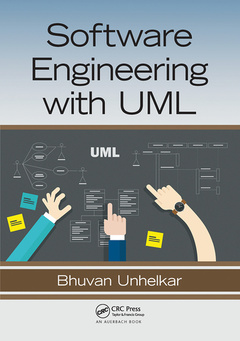Description
Software Engineering with UML
Author: Unhelkar Bhuvan
Language: English
Subjects for Software Engineering with UML:
Keywords
UML Usage; Interaction Overview Diagrams; UML Diagram; Class Diagram; Business Process; State Machine Diagrams; Software Development Process; Vice Versa; UML Notation; Sequence Diagrams; Case Diagram; Case Tool; UML Element; Hospital Management System; Aggregation Relationship; Composite Structure Diagrams; Activity Diagrams; Deployment Diagrams; Package Diagrams; NoSQL Databases; Composite Agile Method; Component Diagrams; Object Diagram; Communication Diagram; Doctor Class
Publication date: 09-2020
· 17.8x25.4 cm · Paperback
Publication date: 12-2017
· 17.8x25.4 cm · Hardback
Description
/li>Contents
/li>Biography
/li>
This book presents the analysis, design, documentation, and quality of software solutions based on the OMG UML v2.5. Notably it covers 14 different modelling constructs including use case diagrams, activity diagrams, business-level class diagrams, corresponding interaction diagrams and state machine diagrams. It presents the use of UML in creating a Model of the Problem Space (MOPS), Model of the Solution Space (MOSS) and Model of the Architectural Space (MOAS). The book touches important areas of contemporary software engineering ranging from how a software engineer needs to invariably work in an Agile development environment through to the techniques to model a Cloud-based solution.
1 Software Engineering Fundamentals with Object Orientation
2 Review of 14 Unified Modeling Language Diagrams
3 Software Projects and Modeling Spaces: Package Diagrams
4 The Software Development Life Cycle and Agility
5 Use Case Models-1: Actors and Use Cases
6 Use Case Models-2: Use Case Diagrams and Requirements Modeling
7 Activity Diagrams, Interaction Overview Diagrams, and Business Process Models
8 Class Models-1: Classes and Business Entities
9 Class Model-2: Basic Class Diagram
10 UML’s Extensibility Mechanisms: Notes, Stereotypes, Constraints, and Tags
11 Class Model-3: Advanced Class Designs
12 Interaction Modeling with Sequence Diagrams
13 Database Modeling with Class and Sequence Diagrams
14 Dynamic Modeling with State Machine Diagrams
15 Advanced Software Engineering Design Concepts: Reuse, Granularity, Patterns, and Robustness
16 Interface Specifications: Prototyping
17 Implementation Modeling with Component, Deployment, and Composite Structure Diagrams
18 Quality of UML Models with Syntax, Semantic, and Aesthetic Checks
19 Software Testing: Plan, Design, and Execute
20 Nonfunctional (Operational) Requirements Specification and Application
21 Emerging Information Technologies and Modeling
Appendix A: Case Study Problem Statements for Team Projects
Bhuvan Unhelkar (BE, MDBA, MSc, PhD; FACS) has more than two decades of strategic as well as hands-on professional experience in Information and Communication Technologies (ICT) industry. As a Founder of MethodScience.com he has notable practical consulting and training expertise in business analysis (use cases, BPMN) software engineering (object modeling, Agile processes and quality), Green IT (environment), enterprise architecture (including SOA), project management, collaborative web services and mobile business. His domain experience includes banking, financial, insurance, government as well as telecommunication organizations wherein he has created industry-specific process maps, quality strategies and business transformation approaches. For the past few years, Dr. Unhelkar has been actively involved in researching into Green IT and the environment – and its application in practice. He has supervised a PhD in the area of Environmentally Responsible Business Strategies (by B. Trivedi) as also set up and delivered a two day training course approved by the Australian Computer Society titled Green IT Design and Implementation (delivered around Australia through Connection Research/Envirability). He is winner of the Consensus IT professional award and the IT writer award under the ‘best author’ category.Dr. Unhelkar earned his Doctorate in the area of "object orientation" from the University of Technology, Sydney, in 1997. Subsequently he designed and delivered course units like Global Information Systems, Object Oriented Analysis and Design, Business Process Reengineering and IT Project Management in the industry as well as across Universities in Australia, China and India. He lead the Mobile Internet Research and Applications Group (MIRAG) at the University of Western Sydney, where he is also an adjunct Associate Professor. He has authored/edited sixteen books in the areas of collaborative business, globalization, mobile business, software quality, business ana




